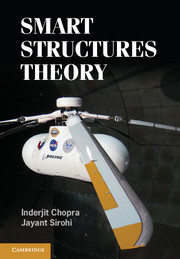Book contents
- Frontmatter
- Contents
- Preface
- 1 Historical Developments and Potential Applications: Smart Materials and Structures
- 2 Piezoelectric Actuators and Sensors
- 3 Shape Memory Alloys (SMAs)
- 4 Beam Modeling with Induced-Strain Actuation
- 5 Plate Modeling with Induced-Strain Actuation
- 6 Magnetostrictives and Electrostrictives
- 7 Electrorheological and Magnetorheological Fluids
- 8 Applications of Active Materials in Integrated Systems
- Index
- References
1 - Historical Developments and Potential Applications: Smart Materials and Structures
Published online by Cambridge University Press: 18 December 2013
- Frontmatter
- Contents
- Preface
- 1 Historical Developments and Potential Applications: Smart Materials and Structures
- 2 Piezoelectric Actuators and Sensors
- 3 Shape Memory Alloys (SMAs)
- 4 Beam Modeling with Induced-Strain Actuation
- 5 Plate Modeling with Induced-Strain Actuation
- 6 Magnetostrictives and Electrostrictives
- 7 Electrorheological and Magnetorheological Fluids
- 8 Applications of Active Materials in Integrated Systems
- Index
- References
Summary
The quest for superior capability in both civil and military products has been a key impetus for the discovery of high performance new materials. In fact, the standard of living has been impacted by the emergence of high performance materials. There is no doubt that the early history of civilization is intertwined with the evolution of new materials. For example, different eras of civilization are branded with their material capabilities, and these periods are referred to as the Stone Age, the Bronze Age, the Iron Age, and the Synthetic Material Age. The Stone Age represents the earliest known period of human civilization that stretches back to one million years BC, when tools and weapons were made out of stone. The Bronze Age (sometimes called the Copper Age) spans 3500–1000 BC. Weapons and implements were made of bronze (an alloy of copper and tin) during this period. The alloy is stronger than either of its constituents. Bronze was used to build weapons such as swords, axes, and arrowheads; implements such as utensils and sculptures; and other industrial products. The Iron Age followed the Bronze Age around 1000 BC and was characterized by the introduction of iron metallurgy. Iron ores were plentiful (cheap) but required high-temperature (2800°F) furnaces as compared to copper, which required lower-temperature (1900°F) furnaces. The Iron Age was the age of the industrial revolution, and many of the initial design tools, mechanics-based analyses, and material characterizations were formulated during this period.
- Type
- Chapter
- Information
- Smart Structures Theory , pp. 1 - 112Publisher: Cambridge University PressPrint publication year: 2013

